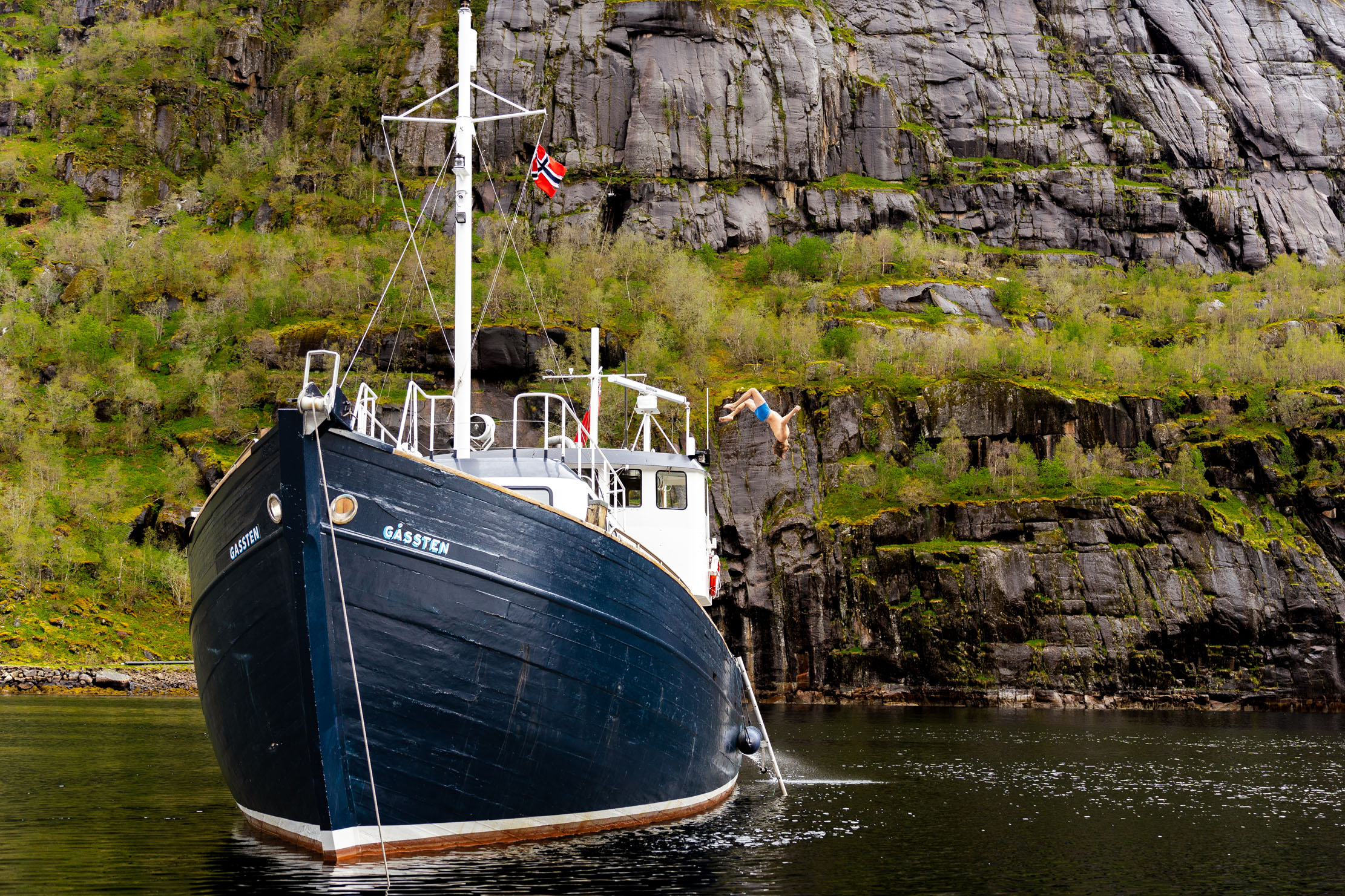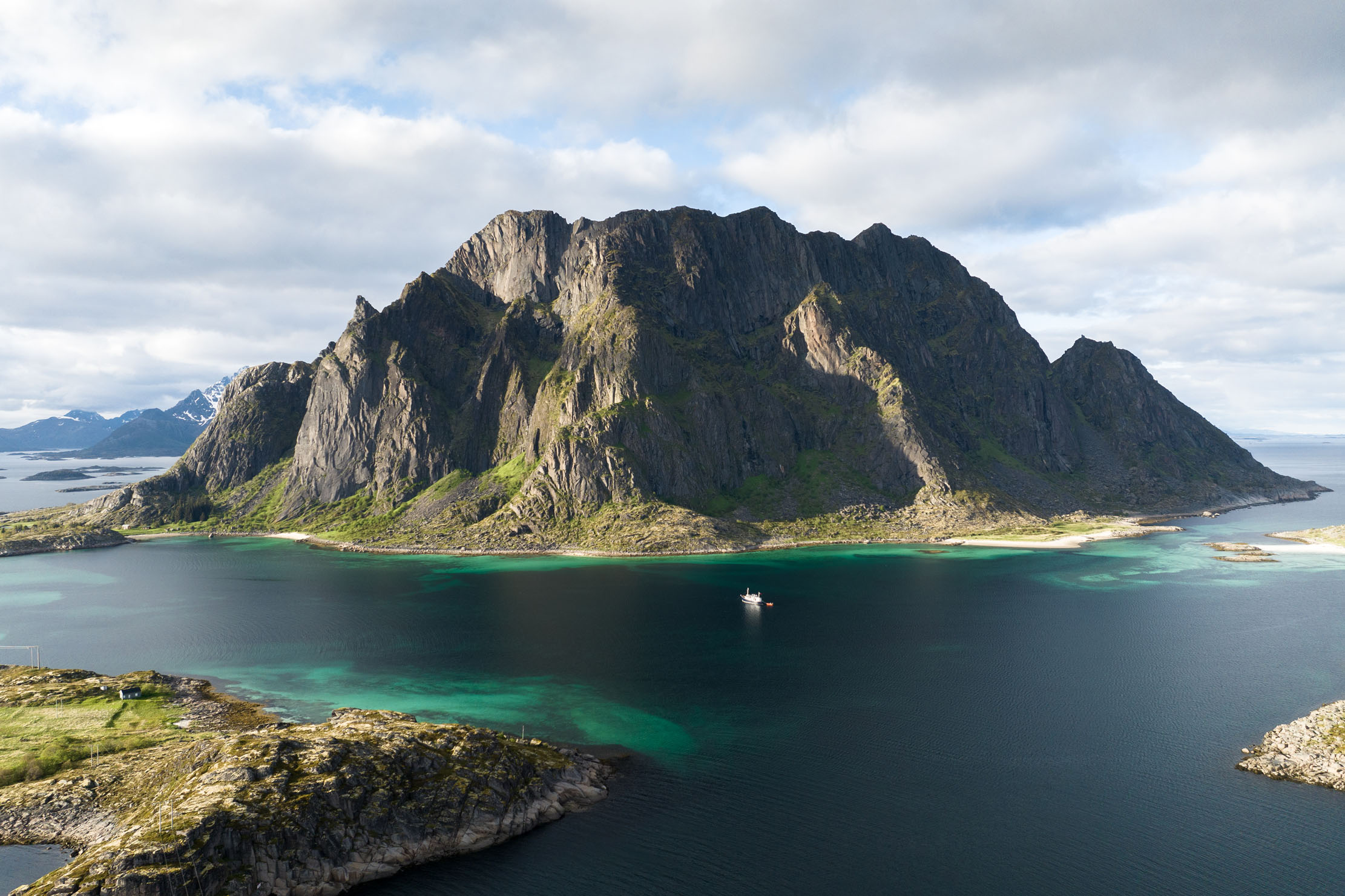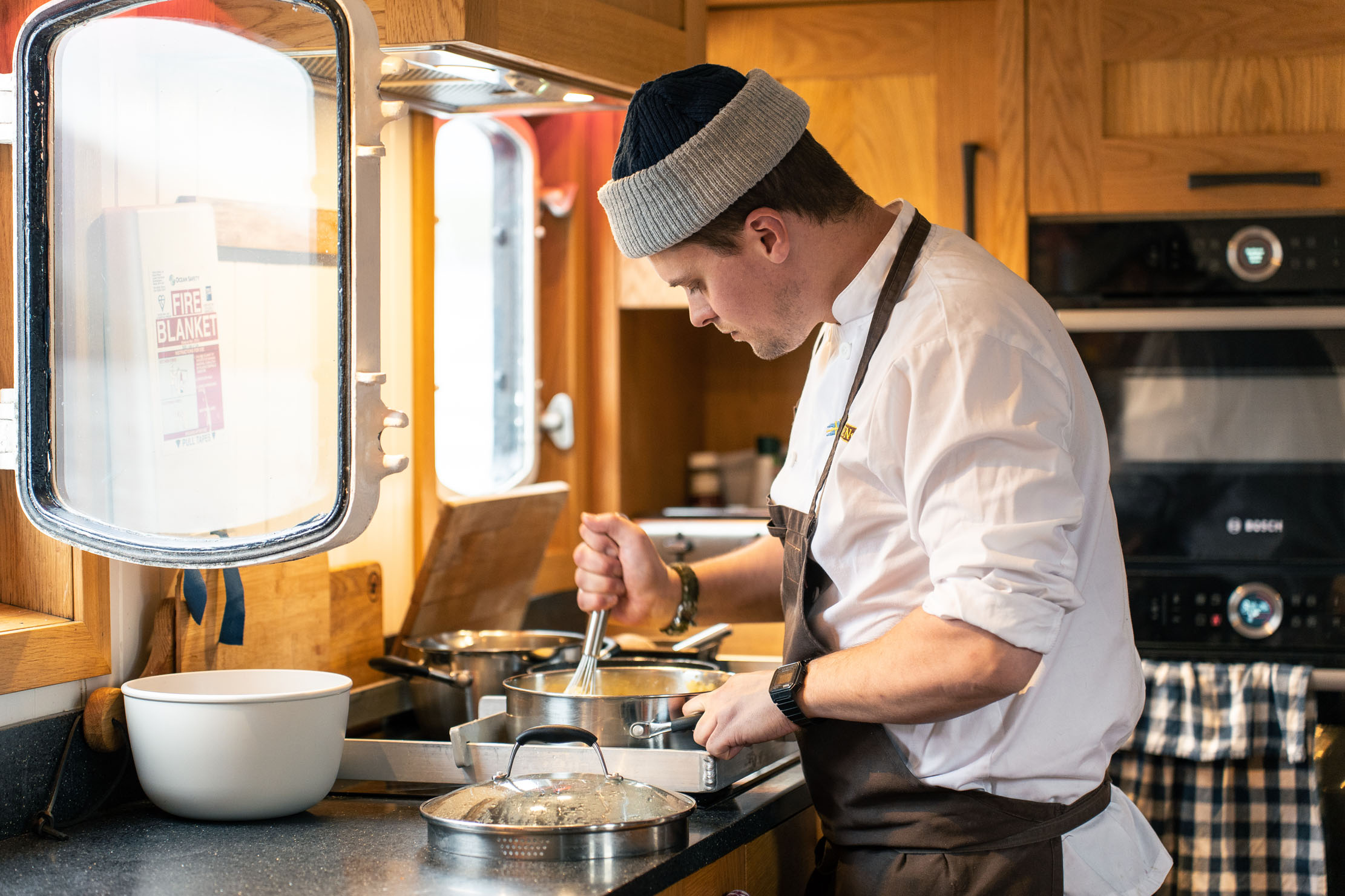The minesweeper that became a tourist cruiser: Life aboard HMS Gåssten
A veteran minesweeper is enjoying a new lease of life as a charter boat touring majestic Norwegian islands. Hugh Francis Anderson sails away on HMS Gåssten; photographs by Tord Karlsen.


The tolling sound of a distant bell rouses me from my slumber. I peel my eyes open. ‘Where am I?’ The room is dark and warm and smells of oiled oak. And then I remember. I’m in Arctic Norway, onboard a Swedish former minesweeping vessel called HMS Gåssten.
The tolling sound is getting louder and louder, now interspersed with a bellowing voice that I recognise as Simon Idsø — the boat’s chef. ‘Orcas,’ he cries. ‘Wake up, there are orcas.’ I exit my cabin — once home to the ship’s ammunition — and scurry onto deck. To the left of the bow bolts of golden light have successfully broken through leaden clouds; to the right, the water’s surface is interrupted by one onyx dorsal fin after another, a symphony of orcas rising and falling. Minutes pass before I realise that I’m not the only one on deck — my group stands silently, in bemused awe.
Our journey begins sometime before the orcas’ arrival in Henningsvaer, a quaint fishing village on the south-west of the Lofoten archipelago. Gåssten’s Royal Navy-blue hull see-saws back and forth on its mooring. Built in 1973, Gåssten spent 26 years sweeping the Baltic Sea and the Gulf of Bothnia for mines before serving the UN as a coast guard vessel. Now, the last ship in her class still afloat, gentle adventures around Lofoten seems a fitting retirement for her. As she lies at anchor, skrei cod dries on wooden racks along the harbour’s edge, as it has done for centuries (the technique preserves the fish and means it can be stored almost indefinitely and shipped long distances), its distinctive scent passed around by the breeze.

There’s something of the old world here, a fitting place for one of the last wooden-hulled warships ever to be built to live out her days. British-owned — and available for private charter through luxury travel operator Pelorus, true champions of bespoke itineraries — Gåssten underwent an extensive refit in 2019 and now boasts four cabins with room for eight guests. Much of the oak used in the refit in Leith came directly from Glamis Castle, childhood home of the Queen Mother. It’s a little slice of home floating in the majesty of Norway’s landscape and a continuation of British travellers’ love affair with the country.
Norway’s rich hunting and fishing grounds first attracted the British in the 1830s and tourism flourished when Thomas Bennett opened Bennett Reisebureau in Christiana (Oslo) in 1850. In Bennett’s Handbook for Travellers in Norway, published in the same year, he wrote: ‘Nature lavishly endowed the country with a rich store of wonders; its attractions are not only strikingly grand, but so varied and numerous as to make a trip in Norway a constant transformation scene.’ It’s a sentiment Gåssten’s British skipper Jamie Milne wants guests to feel today. ‘The rugged rural nature of Lofoten is spectacular and many places are only accessible by boat,’ he says. ‘By combining nature with the historic charm of Gåssten, a close-knit crew and intimate private groups, the entire experience is more enriching. There’s nothing else like it up here.’
Before departure, we are whisked away on a tender to the island of Lille Vakhusøya and the geodesic glass cabin that crowns it. Inside, we feast on reindeer fillet from the north of Norway, asparagus from the south and smoked cod’s roe from Lofoten. ‘We want to provide an authentic gastronomic experience for guests that incorporates local produce and cuisine,’ says Mr Milne. ‘I try to invite local chefs onboard, to find those who have lived and experienced this place and bring their own stories to each dish.’
Back aboard Gåssten, Mr Milne fires up the engines and we cruise out of the harbour. The striking peak of Vågakallen to the north is momentarily revealed by parting, dense cumulus clouds as I sit on deck underneath the protective warmth of a woollen blanket. It’s late by the time we anchor in the bay of Ørsvågen and are lulled to sleep.
Sign up for the Country Life Newsletter
Exquisite houses, the beauty of Nature, and how to get the most from your life, straight to your inbox.

Bright and early, we disembark for a Finnish sauna experience inside Skårungen Spa, before venturing overland to Hov Gård to explore the island of Gimsøy on horseback (guests can also turn their hand to hiking, climbing, cycling and so on). Drizzle sets in as we mount our Icelandic ponies and hack along coastal paths. The scenery has morphed and is remarkably reminiscent of the Inner Hebrides. As one of the oldest settlements in Lofoten, the land has a rich Norse heritage, dating back more than 1,000 years.
Travel in the winter — the boat operates all-year round — and you’ll find a different, snowier scene altogether. The area draws in skiers from across the globe; aboard Gåssten, groups chug up majestic fjords in search of corridors of the untouched powder that carpets peaks, only accessible by boat, from summit to sea.
Sometime later, we lift anchor and depart for Trollfjord, one of Lofoten’s most picturesque spots. I join Mr Milne in the wheelhouse and am offered the helm. ‘I always say that guests are welcome anywhere onboard and can be as involved as they like,’ he tells me. ‘If you charter Gåssten, you charter all of her.’ Soon, the narrow mouth of Trollfjord appears and we steer a course in. The monzonite northern wall rises to around 1,640ft, and we skirt its base as meltwater trickles down from on high. We are alone in the land of Norse mythology and duly embrace our inner Vikings by plunging into the brisk 8˚C waters before a banquet of freshly caught Arctic char in the remodelled saloon.
There is evidence of human activity in and around Lofoten dating back about 11,000 years, long before the Viking Age, but some of the best remains date back to the time when the Scandinavian seafaring warriors ruled the land. In 1983, archaeologists uncovered a 272ft-long longhouse on Vestvågøy island. To date, it’s the biggest Viking house ever found. Its last occupant is believed to be Olaf Tvennumbruni, a Lofoten Viking chieftain, whose subjects believed he could transform into an animal (specifically a werewolf).
On the island of Skrova — sometimes nicknamed the Arctic Hawaii — we glide over crystalline waters, into hidden coves and along white sandy beaches, alongside guides from Skrova Kayak. Back on dry land, our chef, Mr Idsø, former sous-chef to Halvar Ellingsen, one of Norway’s most eminent cooks, disappears mid hike to forage for fireweed, ground elder, chickweed, sorrel and pea cress. ‘I’ll use these tonight to complement the Lofoten lamb,’ he says upon reappearing. ‘We really try to source as much locally as we can to help showcase Norwegian flavours and ingredients.’
As we motor across the sound to Litlmolla and our final night aboard, we’re blessed with some warmth from the midnight sun. It’s odd to think that the one of the coldest and most inhospitable places on earth, the Arctic Circle, also experiences an eternal summer, but it’s a juxtaposition that suits Gåssten — a hardened warship now bearing close-knit groups of friends and family through peaceful waters.
HMS ‘Gåssten’ is available for private charter with Pelorus, from £50,400 a week (www.pelorusx.com). The price is based on eight people staying in four cabins and includes full-board accommodation, a four-person crew, the use of paddleboards and fishing equipment, all fuel, transfers to and from Svolvaer Airport and transport during the trip as per the itinerary
Country Life is unlike any other magazine: the only glossy weekly on the newsstand and the only magazine that has been guest-edited by HRH The King not once, but twice. It is a celebration of modern rural life and all its diverse joys and pleasures — that was first published in Queen Victoria's Diamond Jubilee year. Our eclectic mixture of witty and informative content — from the most up-to-date property news and commentary and a coveted glimpse inside some of the UK's best houses and gardens, to gardening, the arts and interior design, written by experts in their field — still cannot be found in print or online, anywhere else.
-
 Designer's Room: A solid oak French kitchen that's been cleverly engineered to last
Designer's Room: A solid oak French kitchen that's been cleverly engineered to lastKitchen and joinery specialist Artichoke had several clever tricks to deal with the fact that natural wood expands and contracts.
By Amelia Thorpe
-
 Chocolate eggs, bunnies and the Resurrection: Country Life Quiz of the Day, April 18, 2025
Chocolate eggs, bunnies and the Resurrection: Country Life Quiz of the Day, April 18, 2025Friday's quiz is an Easter special.
By James Fisher